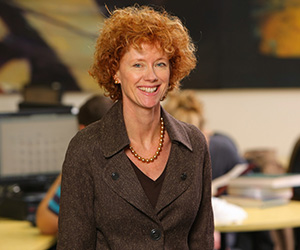If libraries are to be not only repositories of society’s memory and symbols of its identity but the heart of larger social centers, then these changes must be made consciously from an intellectually strong institution that recognizes its exemplary role, and teaches us what books can do: show us our responsibilities toward one another, help us question our values and undermine our prejudices, lend us courage and ingenuity to continue to live together, and give us illuminating words that might allow us to imagine better times [. . .]”
- ALBERTO MANGUEL New York Times, OCT. 23, 2015
Today’s libraries aren’t what they were — or what you might have thought they were.
With the recent launch of Dalhousie’s and the municipality’s beautiful Halifax Central Library, people are expanding their concept of libraries and the role they play in everything from research to community development. Academic libraries, in particular, play a pivotal role in connecting teaching, information and technology. Their goal: create dynamic and welcoming learning environments and services to support the development of successful students and scholars.
consist of five libraries and three learning commons spread over four campuses in Halifax and Truro. Each library has its own focus, supporting one or more of Dal’s faculties and providing a gateway to the full range of Dal Libraries services and resources.
In addition to collecting traditional printed books, the Libraries offer access to nearly 95,000 e-journals and more than 537,000 e-books, a music collection room (which includes a piano people can play), a GIS Centre, 3D printing, and the largest university archive in Atlantic Canada. Reference and research consultations, document delivery, the provision of data sets, research data management planning and preservation, Open Access article deposits and other Institutional Repository services and digitization are also available. You’ll also find Brightspace and Blackboard support, IT Helpdesk assistance, a wide range of workshops, author readings, support for the development of Open Educational Resources (open e-textbooks), and e-journal hosting.
“The Libraries staff will tell you that they are thanked frequently for the services and resources we provide,” says Donna Bourne-Tyson, university librarian. “We also hear very positive comments regarding our spaces... everyone has a favourite corner in one of the libraries or learning commons where they feel most inspired and productive.”
Writing a new chapter
Providing access to the range of resources required for a major research library system in Canada, and all of the associated services, can be a challenge.
 “Libraries in Canada are grappling with a 25 per cent devaluation in the Canadian dollar, which is a potentially crippling loss of buying power for library purchases,” Bourne-Tyson notes. “[. . .] we are fortunate to have the support of the president, provost and vice-president of administration and finance, who have managed to add over $400,000 in the budget to protect us against this loss.”
“Libraries in Canada are grappling with a 25 per cent devaluation in the Canadian dollar, which is a potentially crippling loss of buying power for library purchases,” Bourne-Tyson notes. “[. . .] we are fortunate to have the support of the president, provost and vice-president of administration and finance, who have managed to add over $400,000 in the budget to protect us against this loss.”
That many of the acquisitions relate to digital titles reflects how the role of an academic library continues to evolve, keeping pace with the emerging needs of the university community. Dal’s Libraries have responded to the changing needs of users by continuing to offer new and innovative services and learning spaces.
The latest learning space development, is shared with LaunchDal. Managed by the Norman Newman Centre for Entrepreneurship, this is a space for student teams, faculty members and community mentors to come together and collaborate on innovative entrepreneurial start-up projects. The Collider is based on the ‘stadium’ concept which allows for the space to be shared: until 3 p.m. it’s common-pool classroom space, at which point it becomes the “home of the Collider’” until 9 p.m. when it reverts back to general student study space.
Student study spaces are key, as research libraries accommodate learning styles that range from silent study to vibrant collaborative engagement. Dal’s learning commons promote academic team work, group and individual studying, along with access to computers and information resources. There are currently three learning commons: the Killam Memorial Library Learning Commons, the Wallace McCain Learning Commons, which opened on October 15, and the Kellogg Library Learning Commons in the Collaborative Health Education Building, which opens January 4th. Eventually there will be a fourth learning commons on the Sexton campus.

“It’s great to be able to offer Dal students a range of choices for learning spaces,” says Bourne-Tyson. “The McCain family’s generous gift has given us a beautiful facility that has been quickly adopted by students as a well-loved and heavily used learning space, and I’m sure that there will be lots of enthusiasm surrounding the Kellogg Library Learning Commons when it opens for business on January 4.”
In addition to her responsibilities on campus as University Librarian, Bourne-Tyson is currently serving in the role of vice-president of CARL: the Canadian Association of Research Libraries. In that role, she provides the Dal Libraries with a profile in a national organization while working with other university librarians and deans of libraries to share best practices for all aspects of research library management.
“CARL is making important contributions with partners like CANARIE, Compute Canada, CUCCIO and Research Data Canada and is working with other national leaders towards the development of a digital infrastructure to support research in Canada, through the Leadership Council for Digital Infrastructure,” says Bourne-Tyson.
Helping researchers manage data
One of CARL’s projects is a national Digital Research Strategy which aims to enable open-access data to researchers across Canada. Part of this includes the launch of Portage, which “brings together existing library-based initiatives in the area of research data management in order to better coordinate activities and build capacity. The aim is to implement a library-based research data management network in Canada.” (CARL website).
— a national, open, bilingual data management planning tool that assists researchers throughout their projects — is now available. This tool takes users step-by-step through a series of questions based on a general template for research data stewardship. It is freely available to all researchers in Canada and provides specialized guidance to help researchers utilize the tool to develop their plan. Dalhousie librarians are available to assist researchers with the completion of a data management plan, and the development of associated metadata.
A research data management plan marks the beginning of the research data lifecycle, and permanent preservation of the data and related publications via a deposit in DalSpace — the university’s Institutional Repository, can mark the end. The Dal Libraries are providing ‘cradle to grave’ research data management services.
“This is a new area for research libraries and another way we can support the large and thriving research community at Dalhousie,” notes Bourne-Tyson “With our team of librarians and library IT technicians, working in concert with the Research Services Office, ITS, and regional partners such as AceNet, Dal’s researchers have at their disposal all of the digital tools and infrastructure required to do world-class, ground-breaking research.”
New technologies, and innovations in teaching and learning will continue to lead to the development of exciting new services and spaces offered to students, faculty and staff in the years ahead by the Dal Libraries.
.

